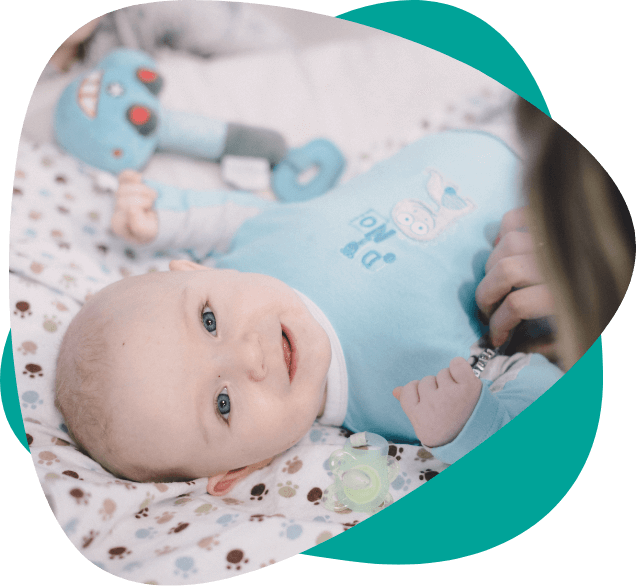Head shape irregularities
A normal baby head shape looks a little bit like an egg when you look down at it from above: symmetrical and wider at the back and narrower at the front. The medical term for a baby’s head with normal dimensions and proportions are Normocephaly. If your baby does not appear to have Normocephaly, it might be that your baby has a type of flat head syndrome or another condition causing their irregular head shape.

- Home >
- Head Abnormalities
Types of Flat Head Syndrome
Flat head syndrome is a condition that occurs when a baby’s head develops a flat spot, either on the back or side of the head, due to prolonged pressure on one part of the skull. In some cases, flat head syndrome may also be caused by underlying medical conditions or abnormalities in the skull. Treatment for flat head syndrome can include repositioning techniques, tummy time, physical therapy, and the use of cranial remoulding helmets. The earlier the condition is diagnosed and treated, the better the chances of a full recovery.

The bones in a baby’s skull are soft and the pressure of lying in the same sleeping position or during birth can cause their head to change shape. Parents usually notice a flat head in babies at around eight weeks of age, when they notice that their baby’s head seems slightly wide, the ear is pushed forward on one side, or the brow is more prominent. There are different categories, depending on which part of the head has flattened. A baby might show more than one of these at once.
Other conditions causing irregular head shapes
Not all head shape irregularities are because of flattening. There are other head shape deformities and conditions that often get confused as types of flat head syndrome. We treat these conditions differently.
These are the medical terms for the other conditions that could be causing the deformity or irregularity in your baby’s head.

Where does my baby fit in?
Not all babies fit neatly into these categories. Typically, babies are brought to us with a combination of brachycephaly and plagiocephaly, but we sometimes see a combination of scaphocephaly and plagiocephaly too. This doesn’t mean that a baby has two types of flat head syndrome; it just describes the position of the flattening. Some researchers tend to mix these two different types of deformities, putting them together under one ‘flat head syndrome’ umbrella. At Technology in Motion, we always classify each head shape so that we know exactly where to allow the head to grow during treatment. We monitor treatment carefully and provide detailed reports so parents know exactly how their children are progressing.
Do the Different Types of Flat Head Syndrome Need to be Treated?

Here at Technology in Motion, we see a variety of baby head shapes of different severities. Some parents catch their baby’s flat head syndrome very early on in which case we recommend utilising repositioning techniques to correct the plagiocephaly or brachycephaly. These techniques are usually successful when started at an early age and when the flat head syndrome condition is still relatively mild.
However, although these measures are often successful for mild cases, they often aren’t enough to correct more severe cases of flat head syndrome in babies, particularly if repositioning techniques haven’t worked thus far. In such circumstances, our effective cranial helmet treatment can work wonders in correcting a head shape, as long as babies are between the age of 4 and 14 months, with the best results being achieved between 4 and 7 months of age.
As the prevalence of flat head syndrome increased after the important back to sleep campaign in the 1990’s, the true effects of untreated flat head syndrome haven’t had a lot of coverage as many of that generation are still relatively young.
However, it is truly important for parents to be aware of the effects of untreated conditions when deciding whether to opt for treatment or not. Our previous guide explains the long-term effects associated with plagiocephaly, which are also relevant to brachycephaly. Our blog post on untreated flat head syndrome covers some further points.
Need advice?
Visit our support page for more information.
Our experts are happy to answer all your questions and provide the best solutions.
Let’s take on the future together
Our specialists are here to provide honest, objective clinical advice. If you have a question or need advice, get in touch with our friendly team.